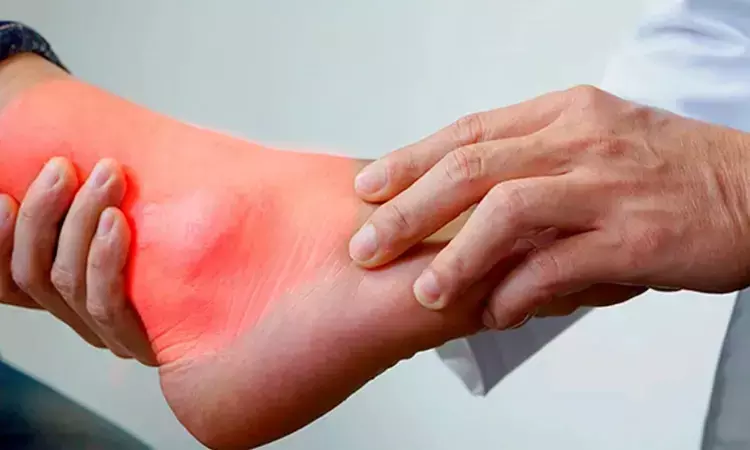- Home
- Medical news & Guidelines
- Anesthesiology
- Cardiology and CTVS
- Critical Care
- Dentistry
- Dermatology
- Diabetes and Endocrinology
- ENT
- Gastroenterology
- Medicine
- Nephrology
- Neurology
- Obstretics-Gynaecology
- Oncology
- Ophthalmology
- Orthopaedics
- Pediatrics-Neonatology
- Psychiatry
- Pulmonology
- Radiology
- Surgery
- Urology
- Laboratory Medicine
- Diet
- Nursing
- Paramedical
- Physiotherapy
- Health news
- Fact Check
- Bone Health Fact Check
- Brain Health Fact Check
- Cancer Related Fact Check
- Child Care Fact Check
- Dental and oral health fact check
- Diabetes and metabolic health fact check
- Diet and Nutrition Fact Check
- Eye and ENT Care Fact Check
- Fitness fact check
- Gut health fact check
- Heart health fact check
- Kidney health fact check
- Medical education fact check
- Men's health fact check
- Respiratory fact check
- Skin and hair care fact check
- Vaccine and Immunization fact check
- Women's health fact check
- AYUSH
- State News
- Andaman and Nicobar Islands
- Andhra Pradesh
- Arunachal Pradesh
- Assam
- Bihar
- Chandigarh
- Chattisgarh
- Dadra and Nagar Haveli
- Daman and Diu
- Delhi
- Goa
- Gujarat
- Haryana
- Himachal Pradesh
- Jammu & Kashmir
- Jharkhand
- Karnataka
- Kerala
- Ladakh
- Lakshadweep
- Madhya Pradesh
- Maharashtra
- Manipur
- Meghalaya
- Mizoram
- Nagaland
- Odisha
- Puducherry
- Punjab
- Rajasthan
- Sikkim
- Tamil Nadu
- Telangana
- Tripura
- Uttar Pradesh
- Uttrakhand
- West Bengal
- Medical Education
- Industry
Clinical practice guidelines on gout management disagree on when to initiate urate-lowering therapy

Australia: A recent article published in BMC Rheumatology has shed light on the core recommendations for gout management in first-line and specialist care by conducting a systematic review of clinical practice guidelines.
An analysis of six clinical practice guidelines showed disagreement on when to initiate urate-lowering therapy for gout, length of urate-lowering therapy, and the use of pegloticase, vitamin C, losartan, and fenofibrate.
The guidelines agreed on the use of urate-lowering therapy for the management of established gout, along with prophylaxis for the prevention of future flares.
"Gout is the most common inflammatory arthritis, increasing in burden and prevalence. Of the rheumatic disease, gout is the best-understood and potentially most manageable condition," Brooke Conley, The University of Melbourne, Melbourne, VIC, Australia, and colleagues wrote in their review. "However, it frequently remains poorly managed or untreated.
The systematic review was conducted to identify Clinical Practice Guidelines (CPG) regarding gout management, assess their quality, and provide a synthesis of consistent recommendations for high-quality CPGs.
The research team included Gout management CPGs if they were (1) written in English and published between 2015 and 2022, focused on adults above 18 years of age, and met the criteria of a CPG, and (2) were rated as high-quality on the AGREE (Appraisal of Guidelines for Research and Evaluation) II instrument. They searched for online guideline repositories.
The authors reported the following findings:
· Six CPGs were appraised as high quality and included in the synthesis.
· Clinical practice guidelines consistently recommended education, commencement of non-steroidal anti-inflammatories, colchicine or corticosteroids (unless contraindicated), and assessment of cardiovascular risk factors, renal function, and co-morbid conditions for acute gout management.
· Consistent recommendations for chronic gout management were urate-lowering therapy (ULT) and continued prophylaxis recommended based on individual patient characteristics.
· Clinical practice guideline recommendations were inconsistent on when to initiate ULT and length of ULT, vitamin C intake, and use of pegloticase, losartan, and fenofibrate.
The synthesis of current high-quality CPGs guided healthcare providers, on recommended gout care. Recommendations from six CPGs were that management of acute gout flare should include education, anti-inflammatories, screening, and elevation/rest of the affected joints.
The article stated, "Established gout should be managed with urate-lowering therapy and continued prophylaxis to manage tophaceous and erosive gout and prevent further gout flare. CPGs disagreed on when to initiate ULT and ULT length, losartan, fenofibrate, pegloticase, and vitamin C intake."
"This synthesis of recommendations is pertinent to healthcare providers and can be implemented in clinical practice to optimise patient outcomes and standardise high-quality care," the investigators concluded.
Reference:
Conley, B., Bunzli, S., Bullen, J. et al. What are the core recommendations for gout management in first line and specialist care? Systematic review of clinical practice guidelines. BMC Rheumatol 7, 15 (2023). https://doi.org/10.1186/s41927-023-00335-w
Dr Kamal Kant Kohli-MBBS, DTCD- a chest specialist with more than 30 years of practice and a flair for writing clinical articles, Dr Kamal Kant Kohli joined Medical Dialogues as a Chief Editor of Medical News. Besides writing articles, as an editor, he proofreads and verifies all the medical content published on Medical Dialogues including those coming from journals, studies,medical conferences,guidelines etc. Email: drkohli@medicaldialogues.in. Contact no. 011-43720751


